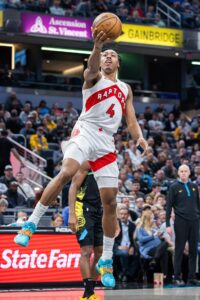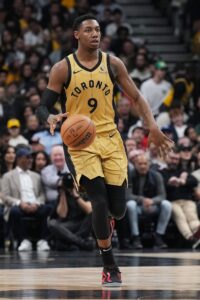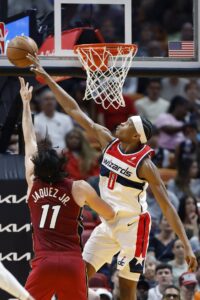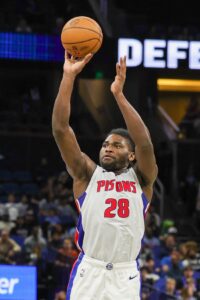The 2023 offseason was one of the most dramatic in Trail Blazers history. Never able to find optimal complementary pieces around Damian Lillard during his 11 years with the franchise, Portland decided to keep the No. 3 overall pick and draft Scoot Henderson instead of, perhaps, finding immediate help using the selection on the trade market, as the seven-time All-NBA guard had hoped.
Lillard responded by requesting a trade, which is seemingly what general manager Joe Cronin was hoping for, even if he’d never admit that publicly. It’s not like it was a surprising outcome. Having the No. 3 overall pick in what was considered a strong draft is a rare opportunity. Not using it for veteran help was essentially a bet against Lillard’s future and an acknowledgement of the state of the roster at the time.
I’m not saying Cronin was wrong to feel that way. Nor was Lillard wrong for asking out. The two sides were just on drastically different timelines. Lillard is a small, offense-first guard who relies on athleticism to get separation and draw fouls. He turns 34 in July.
Portland already had Anfernee Simons and Shaedon Sharpe, two young scoring guards, on the roster before they chose Henderson, another guard. The writing was on the wall.
 2023/24 was an injury-riddled season for the Blazers, who finished just 21-61, tied for the second-worst mark in franchise history. Trade acquisition Robert Williams played only six games before undergoing season-ending knee surgery. Malcolm Brogdon, who was also acquired from Boston in the Jrue Holiday deal, played 39. Sharpe played 32. Simons, 46. Jerami Grant, 54. Deandre Ayton, 55. Henderson, 62.
2023/24 was an injury-riddled season for the Blazers, who finished just 21-61, tied for the second-worst mark in franchise history. Trade acquisition Robert Williams played only six games before undergoing season-ending knee surgery. Malcolm Brogdon, who was also acquired from Boston in the Jrue Holiday deal, played 39. Sharpe played 32. Simons, 46. Jerami Grant, 54. Deandre Ayton, 55. Henderson, 62.
The Blazers have made a habit of tanking in the second half of the past few seasons, so it’s fair to wonder how many of those injuries were really serious. But the end result was their top rotation players simply didn’t play many games together.
Portland endured four losing streaks of seven-plus games and ended the season on a five-game skid. The team’s -9.0 net rating was identical to that of the last-place Pistons.
Young point guards often struggle as rookies, and Henderson was no exception. Most advanced stats say he was among the worst — if not the worst — rotation regulars in the NBA last season. His .489 True Shooting percentage was particularly dreadful, ranking dead last among all qualifying players.
In addition to their own pick (No. 7 overall), the Blazers control a second lottery selection, No. 14 overall (via Golden State). In a draft that is viewed as being light on top-end talent, the Blazers could go in a number of different directions with those selections. Adding another young guard probably doesn’t make much sense, but anything else is probably on the table.
Despite the abysmal season, there is an interesting mix of young and veteran talent on Portland’s roster. Grant would intrigue a number of contending teams. Same for Brogdon. While he’s a major negative on defense, Simons is a very talented offensive player and could continue to get better. Ayton doesn’t have positive value on his current deal, but he’s still a good player. Henderson disappointed as a rookie, yet plenty of people thought he was the best prospect besides Victor Wembanyama in last year’s draft. Sharpe arguably has the most upside of anyone on the roster and the best chance of being a No. 1 scorer on a great team, and he’s only 20.
The Trail Blazers’ Offseason Plan
As things currently stand, the Trail Blazers project to be over the luxury tax line, which is tentatively set at $171.3MM for ’24/25. They are also facing a minor roster crunch, with 11 players on guaranteed salaries, two lottery picks with guaranteed salary slots, two second-round picks (Nos. 34 and 40) with non-guaranteed slots, the non-guaranteed salaries of Jabari Walker and Toumani Camara, and a team option on Dalano Banton.
Camara is essentially a lock to have his salary guaranteed after a promising rookie campaign, and Walker should feel pretty good about his position too. While Banton had some big games at the end of the season, he also had plenty of clunkers, with an unsustainably high usage rate and very poor overall efficiency. One report said the Blazers are expected to pick up their option on the former second-round pick — I’m not convinced that will happen.
Paying the luxury tax after going 21-61 is not a realistic outcome. That means one of the players making $11MM+ in ’24/25 will likely be traded.
Brogdon is probably the most logical candidate, as he’s on an expiring $22.5MM contract and is also the oldest player on the roster at 31. Moving off that deal would give the Blazers plenty of breathing room below the tax line. It would also remove any concerns about potential extension talks with the ’22/23 Sixth Man of the Year.
However, a report in February stated Portland wants to make a postseason push next season, which is why Grant and Brogdon were not moved before the trade deadline. If that remains the case, maybe Robert Williams ($25.7MM over the next two seasons) or Matisse Thybulle ($22.6MM over the next two seasons, including a player option for ’25/26) will be moved instead.
A healthy Williams would have more trade value than Thybulle, as he’s a better offensive player. But Williams has a long history of knee injuries, having been limited to just 215 regular season games over the course of his six NBA seasons (he has also played 56 playoff contests). The fact that he only played six games last season means his value is likely neutral at best.
Thybulle is what he is at this point — a terrific defender who is a minus on offense. I don’t think the Blazers would get a ton in return for him – possibly a second-rounder or two – but I do think he could net positive assets.
Beginning this summer, teams can use the non-taxpayer mid-level exception, bi-annual exception and room exception to acquire players in trades. Both Williams ($12.4MM) and Thybulle ($11MM) would fit cleanly into the non-taxpayer MLE, which is projected to be worth $12.86MM. Considering this year’s free agent class is pretty underwhelming, the possibility of landing Williams or Thybulle could be appealing to rival teams looking for defensive help.
I seem to be a little higher than consensus on Ayton. He is undoubtedly a frustrating player to watch, because it’s plainly obvious that he has the talent to be more productive than he has been to this point in his career. I don’t think he was worth the max offer sheet Indiana gave him a couple years ago (Phoenix quickly matched it). But when he’s fully engaged, he’s a plus starter who contributes on both ends of the court. In 2021, the Suns were two wins away from their first championship with Ayton as their starting center — that wasn’t a coincidence.
That said, to get the best out of the former No. 1 overall pick, you have to involve him in the offense. That hardly happened at all at the beginning of the season, with Portland’s unstructured offense often leading to ball dominance from its perimeter players. Ignoring your highest-paid player isn’t a great recipe for success.
Ayton has shown throughout his career that his game scales well with additional touches, and that was true after the All-Star break, when he averaged 22.7 points and 12.5 rebounds while shooting .583% from the field (his free throw rate remained alarmingly low). He was also more locked in defensively during that stretch. If the Blazers really want to push for a play-in spot next year, they need Ayton to be a centerpiece.
I don’t think that will happen. While there’s undeniable talent on the roster, too many of the skill sets are redundant. Almost all of their best players look to score first and only Brogdon is a reliable decision-maker. The Blazers ranked last in the league in assists, assist-to-turnover ratio, 3PT% and 2PT% — it’s impossible to have a functional offense when all of those factors coincide.
None of the young guards are great defenders, and the team was also last in the league in defensive rebounding. You can argue some of the team’s issues stemmed from injuries, and that’s fair to a point. But big picture, I think the whole of the roster is less than the sum of its parts.
The Western Conference is extremely competitive. Teams like San Antonio and Memphis, which struggled mightily in ’23/24, should be better next season. That means Portland will have to have good health and considerable progress from Sharpe and Henderson to have any chance at approaching .500 next season. And .500 was five games back of the West’s final play-in spot in ’23/24.
If the Blazers struggle to open ’24/25 and that continues for a few months, Grant and Brogdon will undoubtedly pop up in trade rumors again, regardless of whether they actually get moved.
Salary Cap Situation
Guaranteed Salary
 Deandre Ayton ($34,005,126)
Deandre Ayton ($34,005,126)- Jerami Grant ($29,793,104)
- Anfernee Simons ($25,892,857)
- Malcolm Brogdon ($22,500,000)
- Robert Williams ($12,428,571)
- Matisse Thybulle ($11,025,000)
- Scoot Henderson ($10,259,160)
- Shaedon Sharpe ($6,614,160)
- Kris Murray ($2,990,040)
- Duop Reath ($2,048,780)
- Rayan Rupert ($1,891,857)
- Total: $159,448,655
Non-Guaranteed Salary
- Jabari Walker ($2,019,699)
- Walker’s salary will become guaranteed if he remains under contract through July 20.
- Toumani Camara ($1,891,857)
- Camara’s salary will become guaranteed if he remains under contract through July 20.
- Total: $3,911,556
Dead/Retained Salary
- Eric Bledsoe ($1,300,000)
- Didi Louzada ($268,032)
- Total: $1,568,032
Player Options
- None
Team Options
- Dalano Banton ($2,196,970): Non-Bird rights
- Banton’s salary would be partially guaranteed for $217,533 if his option is exercised.
- Total: $2,196,970
Restricted Free Agents
- None
Two-Way Free Agents
Draft Picks
- No. 7 overall pick ($6,856,440)
- No. 14 overall pick ($4,467,960)
- No. 34 overall pick (no cap hold)
- No. 40 overall pick (no cap hold)
- Total (cap holds): $11,324,400
Extension-Eligible Players
- Deandre Ayton (veteran)
- Malcolm Brogdon (veteran)
- Anfernee Simons (veteran)
- Jabari Walker (veteran)
- Robert Williams (veteran)
Note: Unless otherwise indicated, these players are eligible for extensions beginning in July.
Unrestricted Free Agents
- Moses Brown ($2,093,637 cap hold): Non-Bird rights
- Total (cap holds): $2,093,637
Other Cap Holds
- Rondae Hollis-Jefferson ($2,093,637 cap hold)
- Ben McLemore ($2,093,637 cap hold)
- Keljin Blevins ($1,867,722 cap hold)
- T.J. Leaf ($1,867,722 cap hold)
- Total (cap holds): $7,922,718
Note: The cap holds for these players are on the Trail Blazers’ books from prior seasons because they haven’t been renounced. They can’t be used in a sign-and-trade deal.
Cap Exceptions Available
Note: The Trail Blazers project to be over the cap and over the tax line, but below the first apron. In all likelihood, they’ll shed some salary to get out of the tax. If they were to go above the first apron, they’d lose the non-taxpayer mid-level exception and bi-annual exception and would have access to the taxpayer mid-level exception ($5,183,000).
- Non-taxpayer mid-level exception: $12,859,000
- Bi-annual exception: $4,681,000
- Trade exception: $8,778,377
- Expires on September 27.
- Trade exception: $862,382
- Expires on October 1.
Note: Unless otherwise indicated, trade exceptions don’t expire before the regular season begins.
Luke Adams contributed to this post.

 The good news about the Raptors giving up their 2024 first-round pick is that all of their first-rounders going forward will be unencumbered — if they had kept this year’s pick, they still would’ve owed a lightly protected 2025 first-rounder to the Spurs.
The good news about the Raptors giving up their 2024 first-round pick is that all of their first-rounders going forward will be unencumbered — if they had kept this year’s pick, they still would’ve owed a lightly protected 2025 first-rounder to the Spurs.
 Through the first six games of the Knicks/Pacers series, the home team has dominated. New York has a 3-0 record and a +43 margin at Madison Square Garden, but Indiana has been even better at Gainbridge Fieldhouse, posting a 3-0 record with a +50 margin.
Through the first six games of the Knicks/Pacers series, the home team has dominated. New York has a 3-0 record and a +43 margin at Madison Square Garden, but Indiana has been even better at Gainbridge Fieldhouse, posting a 3-0 record with a +50 margin. The Cavs will have to make a decision on head coach J.B. Bickerstaff, whose future with the club is said to be in “
The Cavs will have to make a decision on head coach J.B. Bickerstaff, whose future with the club is said to be in “ When a new management group takes over a rebuilding team, the first order of business is to establish which of the incumbent players are part of the long-term plan. In the Hornets’ case, there’s one obvious sure thing: Miller, whose impressive rookie season was largely overlooked while
When a new management group takes over a rebuilding team, the first order of business is to establish which of the incumbent players are part of the long-term plan. In the Hornets’ case, there’s one obvious sure thing: Miller, whose impressive rookie season was largely overlooked while 
 In some ways, the Pistons being as dreadful as they were made things a little easier on the Wizards, since Detroit endured a historic 28-game losing streak and has been abysmal for multiple years now. But the Wizards only finished with one more win and a very similar net rating (-8.7 vs. -9.0; somehow the Hornets had the worst mark in the league at -10.6, while Portland was also at -9.0).
In some ways, the Pistons being as dreadful as they were made things a little easier on the Wizards, since Detroit endured a historic 28-game losing streak and has been abysmal for multiple years now. But the Wizards only finished with one more win and a very similar net rating (-8.7 vs. -9.0; somehow the Hornets had the worst mark in the league at -10.6, while Portland was also at -9.0). Jordan Poole
Jordan Poole That goal seemed sensible enough through the first three games of the season, which included a pair of wins and a one-point loss. It looked – to put it mildly – increasingly unrealistic as Detroit lost its next 28 games in a row and 35 of its next 36 in total. Suddenly, the organization’s goal was simply to avoid the embarrassment of posting the NBA’s worst record of all-time. The team avoided that fate, but its 11-32 finish following a 3-36 start was hardly cause for legitimate optimism entering the summer.
That goal seemed sensible enough through the first three games of the season, which included a pair of wins and a one-point loss. It looked – to put it mildly – increasingly unrealistic as Detroit lost its next 28 games in a row and 35 of its next 36 in total. Suddenly, the organization’s goal was simply to avoid the embarrassment of posting the NBA’s worst record of all-time. The team avoided that fate, but its 11-32 finish following a 3-36 start was hardly cause for legitimate optimism entering the summer.